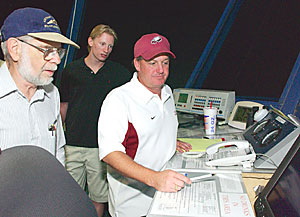 |
|
Chris Coduto/Arizona Daily Wildcat
|
Ryan Airfield controller Dee Webster explains some of the finer points about working in a control tower to members of the UA flying club on Saturday. Members of the club held a potluck at a hangar and were able to go into the tower for tours.
|
|
|
By Seth Mauzy
Arizona Daily Wildcat
Monday, September 26, 2005
Print this
The UA Flying Club kicked off a new semester of flyovers, air shows and all things aviation with their annual hangar party at Ryan Airfield Saturday.
Ryan Airfield, located about 14 miles southwest of Tucson, caters to small private aircraft that fall under the classification of "general aviation."
The hangar party was a chance for existing club members to plan upcoming events as well as for prospective members to get a taste of what is to come in the semester.
Some upcoming events include club fly-outs, in which members or professors who have their own planes or rent them will offer seats to non-pilots for flights over Tucson, or multiple flights are planned for nearby locations like Phoenix and Casa Grande.
"Last year we got three or four planes together and flew to Chandler for breakfast," said Viral Shah, an engineering management senior and treasurer of the club. "We usually plan on having fly-outs over Thanksgiving weekend or over Veteran's Day."
The club also makes a yearly flight to the Copperstate Fly-in, an annual air show for general aviation held in Casa Grande.
"We usually get a group of planes together and fly in over the weekend," Shah said. "It's cool to see all the classic planes on display there."
The party was hosted in the hangar of William Bickel, a physics professor at the UA, which houses his fully-restored bright red 1952 Cessna 170.
"It's completely fixed up and is fully mechanical; no computers," Bickel said. "In this plane you have to do everything yourself."
Bickel said he flies mostly for recreation, but that he also offers "rides to any of my students that I think deserve it."
Two other professors from the physics department had aircraft on display at the party, including Charles Curtis, the club's faculty adviser.
Curtis has put his red and white Cessna 185, which was also on display, to a variety of uses.
"A plane is not just a big toy but a useful thing," Curtis said. "You can use it for travel, research and of course fun, like sightseeing."
Curtis has flown his plane all across the Western Hemisphere for leisure; from Central America to Alaska and from coast to coast, but he also has more academic uses for it.
"It's primarily a research craft. We do a lot of work with the Environmental Research Lab," Curtis said. "I've photographed every inch of the Colorado River from the Grand Canyon down through Mexico to the Sea of Cortez."
Curtis' plane was equipped with a cargo pod, which attaches to the underside of the plane and can be equipped with cameras and other remote sensing gear for use in his research.
Perhaps most impressive was the sleek, cherry-red craft marked "experimental" that was the creation of physics professor emeritus Sigurd Kohler.
The plane, dubbed the RV-7A, was built entirely by Kohler and took 2 1/2 years to complete. Kohler also owns a Cessna 182, but says he prefers the freedom of building his own craft.
"With a home-built (plane) you do everything yourself. You have fewer problems with parts," Kohler said. "I can do all my own maintenance; engine work, anything."
The 20 students in attendance also toured the control tower at Ryan Airfield and learned air traffic control basics from controller Dee Webster.
Webster showed the students how the tower tracks flights using their new radar system, while simultaneously tracking three small planes that were waiting for clearance to land.
Pilots periodically radioing in for instructions interrupted Webster's explanations to the club. Their requests were answered by Webster in a fast stream of jargon that is typical for an airfield.
"They're really big on phraseology in this business," Webster said. "Listening to us talk is like reading books written by lawyers."
